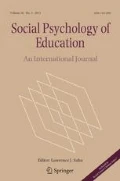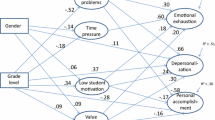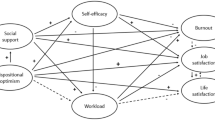Abstract
The school principal's professional world is characterized by overwhelming responsibilities, information perplexities, and emotional anxiety. The main purpose of this study was to map the common work-related stressors encountered by principals and to assess their relative weight in terms of predicting school principal burnout. A sample of 821 elementary and secondary, male and female school principals participated in the study. They completed a self-report questionnaire containing two scales: a burnout scale (measured as a three-dimensional concept consisting of exhaustion, depersonalization, and accomplishment), and a role-pressures scale. Multiple analysis of variance (MANOVA), multiple linear regression, and discriminant function analysis were used in data processing. Findings show that burnout was affected mostly by pressures stemming from teachers and parents, and to a lesser extent, from overload (qualitative and quantitative). Differences between elementary and secondary school principals were noted. The findings imply that principals who feel that their leadership is challenged or rejected feel strongly stressed and eventually burned-out.
Similar content being viewed by others
References
Bacharach, Samuel B. & Conley, Sharon (1986). Uncertainty and decision making in teaching. In Thomas J. Sergiovani & John H. Moore (Eds.), Schooling for tomorrow. Boston: Allyn & Bacon.
Bandura, Albert (1977). Self-efficacy: Towards a unifying theory of behavior change. Psychological Review, 84, 191-215.
Borg, Mark G. & Riding, Richard J. (1993). Occupational stress and job satisfaction among school administrators. Journal of Educational Administration, 31, 4-21.
Burke, Ronald J. (1988). Sources of managerial and professional stress in large organizations. In Cary L. Cooper & Roy Payne (Eds.), Causes, coping and consequences of stresses at work. Chichester: Wiley.
Byrne, Barbara M. (1994). Burnout: Testing for the validity, replication and invariance of causal structures across elementary, intermediate, and secondary teachers. American Educational Research Journal, 31, 645-673.
Carr, Adrian (1994). Anxiety and depression among school principals. Journal of Educational Administration, 32, 18-34.
Carr, Adrian (1994). Anxiety and repression amongst school principals. Journal of Educational Administration, 32, 18-34.
Cattell, Raymond B. (1966). The scree test for the number of factors. Multivariate Behavioral Research, 1, 245-276.
Chaplain, Ronald P. (2001). Stress and job satisfaction among primary headteachers. Educational Management & Administration, 29, 197-215.
Cooper, Cary L. & Kelly, Mike (1993). Occupational stress in head teachers: A national UK study. British Journal of Educational Psychology, 63, 130-143.
Cooper, Cary L. & Marshall, Judi (1978). Sources of managerial and white-collar stress. In Cary L. Cooper & Roy Payne (Eds.), Stress at work. Chichester, England: Wiley; pp. 99-136.
Enzman, Dirk, Schaufeli, Wilmar B. Janssen, Peter, & Rozeman, Alfred (1998). Dimensionality and validity of the burnout measure. Journal of Occupational and Organizational Psychology, 71, 331-351.
Etzion, Dalia & Pines, Ayala (1986). Sex and culture in burnout and coping among human service professionals. Journal of Cross-Cultural Psychology, 17, 191-209.
Etzion, Dalia (1987). Burning out in management: A comparison of women and men in matched organizational positions. Israel Social Sciences Research, 5(1–2), 147-163.
Fiske, Susan T. & Taylor, Shelly E. (1984). Social cognition. Addison-Wesley Publishing Co.
Frankenhaeuser, Marianne (1991). A biopsychosocial approach to work life issues. In Jeffrey V. Johnson & Gunn Johansson (Eds.), The psychosocial work environment: Work organisation, democratization and health. Amityville, N.Y.: Baywood; pp. 49-60.
Friedman, Isaac A. (1996). Multipathways to burnout: Cognitive and emotional scenarios in teacher burnout. Anxiety, Stress and Coping, 9, 245-259.
Friedman, Isaac A. (2000). Burnout in teachers: Shattered dreams of impeccable professional performance. Journal of Clinical Psychology, 56, 595-606.
Frijda, Nico H. (1986). The emotions. Cambridge: Cambridge University Press.
Gaziel, Haim (1993). Occupational stress as experienced by educators. Curriculum and Teaching, 8, 81-90.
Gugliemi, Sergio R. & Tatrow, Kristin (1998). Occupational stress, burnout, and health in teachers: A methodological and theoretical analysis. Review of Educational Research, 68, 61-99.
Karasek, Robert A. (1979). Job demands, job decision latitude, and mental strain: Implications for job redesign. Administrative Science Quarterly, 24, 285-308.
Katz, Malcolm (1988). Georgia principals identify their most troublesome administrative problems. Georgia Educational Leadership Academy Research Report.
Knutton, Stephen & Mycroft, Andrew (1986). Stress and the deputy head. School Organization, 6, 49-59.
Lee, Raymond T. & Ashforth, Blake E. (1993). A further examination of managerial burnout: Toward an integrated model. Journal of Organizational Behavior, 14, 3-20.
Mackler, Jill (1996). A survivor's guide to the principalship: Overcoming the challenges. NASSP Bulletin, 80(577), 84-89.
Mandler, George (1975). Mind and emotions. New York: Wiley.
Maslach, Christina (1995, November). Progress in understanding teacher burnout: A commentary. Paper Prepared for Conference on Teacher Burnout, Marbach, Germany.
Maslach, Christina & Jackson, Suzan E. (1981). The measurement of experienced burnout. Journal of Occupational Behavior, 2, 99-113.
Maslach, Christina & Schaufeli, Wilmar B. (1993). Historical and conceptual development of human burnout. In Wilmar B. Schaufeli, Christina Maslach, & Tadeusz Marek (Eds.), Professional burnout. Washington D.C.: Taylor & Francis; pp. 1-18.
Maslach, Christina & Leiter, Michael (1997). The truth about burnout. San Francisco: Jossey-Bass.
Payne, Roy L. (1979). Demands, supports, constraints and psychological health. In Colin J. Mackay & Tom Cox (Eds.), Response to stress: Occupational aspects. London: International Publishing Corporation; pp. 85-105.
Pines, Ayala, Aronson, Elliot, & Kafry, Ditsa (1981). Burnout: From tedium to personal growth. New York: Free Press.
Sarros, James C. (1988). Administrator burnout: Finding and future directions. The Journal of Educational Administration, 26, 184-196.
Savery, Lawson K. & Detiuk, Michael (1986). The perceived stress levels of primary and secondary principals. The Journal of Educational Administration, 24, 272-281.
Siegrist, Johannes (1996). Adverse health effects of high-effort/low-reward conditions. Journal of Occupational Health Psychology, 1, 27-41.
Torelli, Joseph A. & Gmelch, Watter H. (1992, April). Occupational stress and burnout in educational administration. Paper Presented to the American Educational Research Association Conference, San Francisco, CA.
Ubben, Gerald C. & Hughes, Larry W. (1992). The principal (2nd edn.) Boston: Allyn & Bacon.
Van-Harrison R. (1978). Person-environment fit and job stress. In Cary L. Cooper & Roy Payne (Eds.), Stress at work. Chichester, England: Wiley; pp. 175-205.
Welch, Ira D., Meideros, Donald C., & Tate, George A. (1982). Beyond burnout. Englewood Cliffs, N.J.: Prentice-Hall.
Whitaker, Kathryn S. (1996). Exploring causes of principal burnout. Journal of Educational Administration, 34, 60-71.
Whitaker, Kathryn S. (1999). Principal role changes and implications for principalship candidates. International Journal of Educational Reform, 8, 352-362.
Author information
Authors and Affiliations
Rights and permissions
About this article
Cite this article
Friedman, I.A. Burnout in School Principals: Role Related Antecedents. Social Psychology of Education 5, 229–251 (2002). https://doi.org/10.1023/A:1016321210858
Issue Date:
DOI: https://doi.org/10.1023/A:1016321210858




